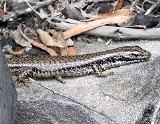
Eulamprus
Encyclopedia
Eulamprus, the water skinks, are a genus
of skink
s in the subfamily Lygosominae
. It belongs to a clade
in the Sphenomorphus
group that contains such genera as Ctenotus
and Anomalopus
. Even closer related to Eulamprus than these two seems the Prickly Skink (Gnypetoscincus queenslandiae).
Hinulia elegans, described by Grey in 1838, is an unidentified lygosomine that may be Eulamprus tenuis.
Genus
In biology, a genus is a low-level taxonomic rank used in the biological classification of living and fossil organisms, which is an example of definition by genus and differentia...
of skink
Skink
Skinks are lizards belonging to the family Scincidae. Together with several other lizard families, including Lacertidae , they comprise the superfamily or infraorder Scincomorpha...
s in the subfamily Lygosominae
Lygosominae
Lygosominae is the largest subfamily of skinks in the family Scincidae. The subfamily can be divided into a number of genus-groups. If the rarely used taxonomic rank of infrafamily is employed, the genus-groups would be designated as such, but such a move would require a formal description...
. It belongs to a clade
Clade
A clade is a group consisting of a species and all its descendants. In the terms of biological systematics, a clade is a single "branch" on the "tree of life". The idea that such a "natural group" of organisms should be grouped together and given a taxonomic name is central to biological...
in the Sphenomorphus
Sphenomorphus
The genus Sphenomorphus – vernacularly known as the common skinks – currently serves as a "wastebin taxon" for a large number of skinks...
group that contains such genera as Ctenotus
Ctenotus
Ctenotus is a genus of skinks . It belongs to a clade in the Sphenomorphus group which contains such genera as Anomalopus and the close relatives Eulamprus and Gnypetoscincus....
and Anomalopus
Anomalopus
Anomalopus is the genus of worm-skinks, smallish smooth-scaled burrowing skinks from the eastern half of Australia...
. Even closer related to Eulamprus than these two seems the Prickly Skink (Gnypetoscincus queenslandiae).
Species
- Eulamprus amplus Covacevich & McDonald, 1980 – Lemon-barred Forest-skink
- Eulamprus brachyosoma (Lönnberg and Andersson, 1915) – Northern Barsided Skink
- Eulamprus frerei Greer, 1992 – Stout Barsided Skink
- Eulamprus heatwolei Wells & Willington, 1983 – Warm-temperate Water-skink
- Eulamprus kosciuskoi Kinghorn, 1932 – Alpine Meadow-skink, Alpine Water Skink
- Eulamprus leuraensis Wells & Willington, 1983 – Blue Mountain Water SkinkBlue Mountain Water SkinkThe Blue Mountain Water Skink is a species of skink in the Scincidae family.It is found only in Australia and is also an endangered species.-References:...
, Blue Mountain Swamp-skink - Eulamprus luteilateralis Covacevich & McDonald, 1980 – Orange-speckled Forest-skink
- Eulamprus martini Wells & Willington, 1983 – Dark Barsided Skink
- Eulamprus murrayi (Boulenger, 1887) – Blue-speckled Forest-skink
- Eulamprus quoyiiEulamprus quoyiiThe Eastern Water Skink, Eastern Water-skink, or Golden Water Skink is a species of diurnal Scincidae that occurs in Australia, primarily in the southeast.-Habitat:...
Quoy & Gaimard, 1824 – Golden Water Skink, Eastern Water-skink, Eastern Water Skink - Eulamprus sokosoma Greer, 1992 – Stout Barsided Skink
- Eulamprus tenuis (Gray, 1831) Bar-sided Forest-skink, Barred-sided Skink
- Eulamprus tigrinus (De Vis, 1888) – Yellow-blotched Forest-skink, Rainforest Water-skink
- Eulamprus tryoni (Longman, 1918) – Border Ranges Blue-spectacled Skink, Forest Skink, Tryon's Skink
- Eulamprus tympanum (Lönnberg and Andersson, 1915) – Southern Water SkinkSouthern Water SkinkThe Southern Water Skink is a medium-sized species of skink that is endemic to Australia. They are found in Victoria as well as on Tasmania's Rodondo Island in Bass Strait. They are viviparous; mating in spring, and giving birth in mid to late summer...
, Cool-temperate Water-skink, Highland Water Skink
Hinulia elegans, described by Grey in 1838, is an unidentified lygosomine that may be Eulamprus tenuis.

